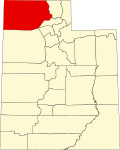2020 census
According to the 2020 United States census [18] and 2020 American Community Survey, [19] there were 57,666 people in Box Elder County with a population density of 10.0 people per square mile (3.9/km2). Among non-Hispanic or Latino people, the racial makeup was 49,361 (85.6%) White, 161 (0.3%) African American, 383 (0.7%) Native American, 438 (0.8%) Asian, 98 (0.2%) Pacific Islander, 102 (0.2%) from other races, and 1,586 (2.8%) from two or more races. 5,537 (9.6%) people were Hispanic or Latino.
There were 29,190 (50.62%) males and 28,476 (49.38%) females, and the population distribution by age was 18,255 (31.7%) under the age of 18, 31,620 (54.8%) from 18 to 64, and 7,791 (13.5%) who were at least 65 years old. The median age was 33.0 years.
There were 18,678 households in Box Elder County with an average size of 3.09 of which 14,609 (78.2%) were families and 4,069 (21.8%) were non-families. Among all families, 11,985 (64.2%) were married couples, 969 (5.2%) were male householders with no spouse, and 1,655 (8.9%) were female householders with no spouse. Among all non-families, 3,482 (18.6%) were a single person living alone and 587 (3.1%) were two or more people living together. 7,722 (41.3%) of all households had children under the age of 18. 14,543 (77.9%) of households were owner-occupied while 4,135 (22.1%) were renter-occupied.
The median income for a Box Elder County household was $63,573 and the median family income was $73,446, with a per-capita income of $25,835. The median income for males that were full-time employees was $52,960 and for females $36,673. 7.9% of the population and 6.4% of families were below the poverty line.
In terms of education attainment, out of the 32,717 people in Box Elder County 25 years or older, 2,325 (7.1%) had not completed high school, 9,937 (30.4%) had a high school diploma or equivalency, 12,701 (38.8%) had some college or associate degree, 5,656 (17.3%) had a bachelor's degree, and 2,098 (6.4%) had a graduate or professional degree.
2010 census
As of the 2010 census, [20] there were 49,975 people, 16,058 households, and 12,891 families in the county. The population density was 8.70 people per square mile (3.36 people/km2). There were 17,326 housing units at an average density of 3.02 units per square mile (1.17 units/km2). The racial makeup of the county was 91.77% White, 0.34% Black or African American, 0.82% Native American, 0.89% Asian, 0.17% Pacific Islander, 3.77% from other races, and 2.24% from two or more races. 8.31% of the population were Hispanic or Latino of any race.
There were 16,058 households, out of which 41.32% had children under 18 living with them, 67.44% were married couples living together, 8.69% had a female householder with no husband present, and 19.72% were non-families. 17.16% of all households were made up of individuals, and 7.39% had someone living alone who was 65 years of age or older. The average household size was 3.09, and the average family size was 3.50.
The county population contained 36.60% under the age of 20, 5.55% from 20 to 24, 25.37% from 25 to 44, 21.35% from 45 to 64, and 11.13% who were 65 years of age or older. The median age was 30.6 years. For every 100 females, there were 101.59 males. For every 100 females aged 18 and over, there were 96.61 males.








